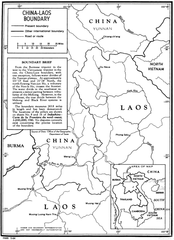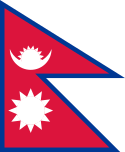Granica chińsko-laotańska
 | |
| Państwa graniczące | |
|---|---|
| Okres istnienia | od 1953 |
| Długość | 424,5 km |
Granica chińsko-laotańska – granica międzypaństwowa między Chinami i Laosem, ciągnąca się na długości 424,5 km od trójstyku z Mjanmą na zachodzie do trójstyku z Wietnamem na wschodzie.
Granica na zachodzie rozpoczyna się od trójstyku granic Mjanmy, Chin i Laosu, znajdującego się na rzece Mekong (współrzędne: 21°33′49,0″N 101°08′38,5″E/21,563611 101,144028), następnie ciągnie się przez 424,5 km (263,8 mi) aż do góry Shiceng Dashan, na której mieści się trójstyk granic Chin, Laosu i Wietnamu (współrzędne: 22°24′02,5″N 102°08′38,5″E/22,400694 102,144028).
Granica powstała po uzyskaniu przez Laos niepodległości (częściowa niepodległość w 1949 roku, pełna niepodległość w roku 1953)[1]. Jest ona jednak identyczna z istniejącą już wcześniej granicą między Chinami i protektoratem Laosu (Indochiny Francuskie), której przebieg zatwierdzono 20 czerwca 1895 roku[2]. Na początku lat 90. XX wieku przeprowadzono prace badawcze i demarkacyjne zwieńczone podpisaniem w 1995 roku porozumienia chińsko-laotańskiego w sprawie przebiegu granicy państwowej[3].
Przypisy
- ↑ Laos Independence Day (ang.). latitudes.nu, 5 lutego 2013. [dostęp 2020-11-26].
- ↑ China – Laos Boundary (ang.). fall.law.fsu.edu, 24 czerwca 1964. [dostęp 2020-11-26]. [zarchiwizowane z tego adresu (2020-11-18)].
- ↑ Ronald Bruce St John: The Land Boundaries of Indochina: Cambodia, Laos and Vietnam. 1998, s. 44–45. ISBN 1-897643-32-2. (ang.)
Media użyte na tej stronie
Flag of Laos
The Flag of India. The colours are saffron, white and green. The navy blue wheel in the center of the flag has a diameter approximately the width of the white band and is called Ashoka's Dharma Chakra, with 24 spokes (after Ashoka, the Great). Each spoke depicts one hour of the day, portraying the prevalence of righteousness all 24 hours of it.
The national flag of Kingdom of Thailand since September 2017; there are total of 3 colours:
- Red represents the blood spilt to protect Thailand’s independence and often more simply described as representing the nation.
- White represents the religion of Buddhism, the predominant religion of the nation
- Blue represents the monarchy of the nation, which is recognised as the centre of Thai hearts.
China-Laos border map

















